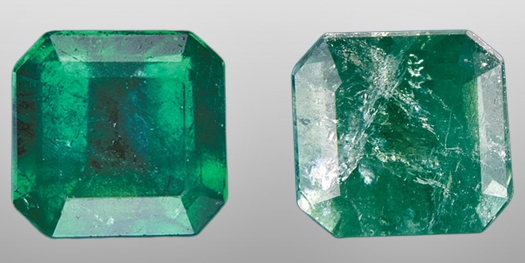- Before Fracture filling
- After Fracture filling
treatment of gemstones
What does “Treatment in Gemstones” mean?
Treatment on gemstones refers to any human process (other than cutting and polishing) which improves the appearance (colour and clarity) or durability of a gem. Gems are treated in different ways like heating, surface diffusion, glass filling, beryllium diffusion, irradiation, fracture filling etc to alter their appearance.
According to a survey done by GIA in 2005 95% ruby and sapphires (blue and yellow) available in the market were treated by heat. In our experience more than 99% rubies and sapphires (blue and yellow) available today are treated in some way or the other.
Untreated gemstones are rarest of the rare gemstones as every piece is a unique creation of mother earth formed in thousands of year. Each gem is distinctive and irreplaceable. In fact it is a matter of fortune to find an untreated gemstone of your choice when you want to own one.
Identifying whether a gemstone is treated or not needs good gemmological knowledge and enough experience. As a customer you can determine if the gemstone you want to buy is treated or not by asking your jeweller to get the gem certified from an internationally recognised laboratory with the details of the status of treatment in the gemstone

The stones which do not get sufficient colour or clarity naturally are heated in furnaces to a very high temperature, which causes the inclusions to deform and alter the colour, making it dark, light, more intense or of a different colour.
What does heat treatment do to the stone?
Heat rearranges the atoms in the stone. As in the case of ruby the stone is heated almost to a point of melting, which lets the aluminium oxide in the stone to reform to what is basically a new crystal structure. This lets the chromium reform to give off a better colour of red. The same can apply to a type of sapphire known as goudasapphires. These are milky white sapphires that turn blue and account for many of the promotional quality sapphires out on the market today.
Price difference in a heated wiz unheated gemstone: For instance a 3.00 carat fine ruby from Burma of natural unheated colour can sell for as much as Rs 10,00,000 while a heated stone of the same colour can go for around Rs 20,000.
Thus you will always want to have a proper gemmological evaluation done for any ruby, sapphire (blue or yellow) etc that you want to own.
Diffusion
Diffusion was originally used on sapphires. Chemicals, like beryllium were infused at high temperatures which actually penetrated the gems. Early diffusion only produced colour on the surface of the gem and was referred to as “Surface Diffusion”. Surface diffusion was easily detectable with immersion, and often with simple magnification.
Great advancements have been made in diffusion treatment in the last decade and it was discovered that if corundum is heated to very high temperatures for a long duration, the diffusion would penetrate the entire stone! It can improve colour and also give a totally different colour to the stone.


Glass/lead Filling:
Filling is used on gems with surface fractures or cavities. Glass, lead or other materials are used to fill these cracks and holes. This is commonly done to rubies. This hides the cavities and also improves colour of the stone.
Lead being a toxic substance is hazardous to health so lead filled rubies should not be worn on everyday basis.
Fracture Filling
It is an inexpensive treatment widely used on emeralds. To make an inferior gem look clearer and more valuable, technicians fill in any surface-breaking fissures with some other material. Literally thousand types of products are used for the filling. Fracture filling makes an emerald look better to the naked eye but microscopic examination can reveal the filled fractures.

Before
After
Irradiation

Before
After
Irradiation means pounding material with subatomic particles or radiation. Irradiation is used to produce yellow sapphires from pale bluish sapphires. The colour produced through this process is not permanent and goes back to the original colour over a period of time.
Cultured pearls can be irradiated to produce gray or blue colors; but dyeing in these colors is more common.
What do I need to know before going shopping?
Always stay with a professional, independent jeweller with some serious gemmological training. There can be a huge price difference in two gemstones that appear the same colour and clarity due to heat treatment alone. And it takes someone with some good experience and good gemmological knowledge to be able to identify one from the other. So stay with someone with a good reputation for quality and expertise.
To be assured about your purchase always take certificate from a laboratory which work on international trade standards.
Coloured gemstone shopping is “business for the eyes and soul” as my Great grandfather once told me. You can’t buy a quality gemstone from someone claiming discounts and you can’t buy a quality gemstone based on a picture on your computer screen. Fine quality gemstones are never discounted because they are too rare. And buying a gemstone without seeing what it looks like to your own eyes is the last thing you would like to do during a wise purchase.
